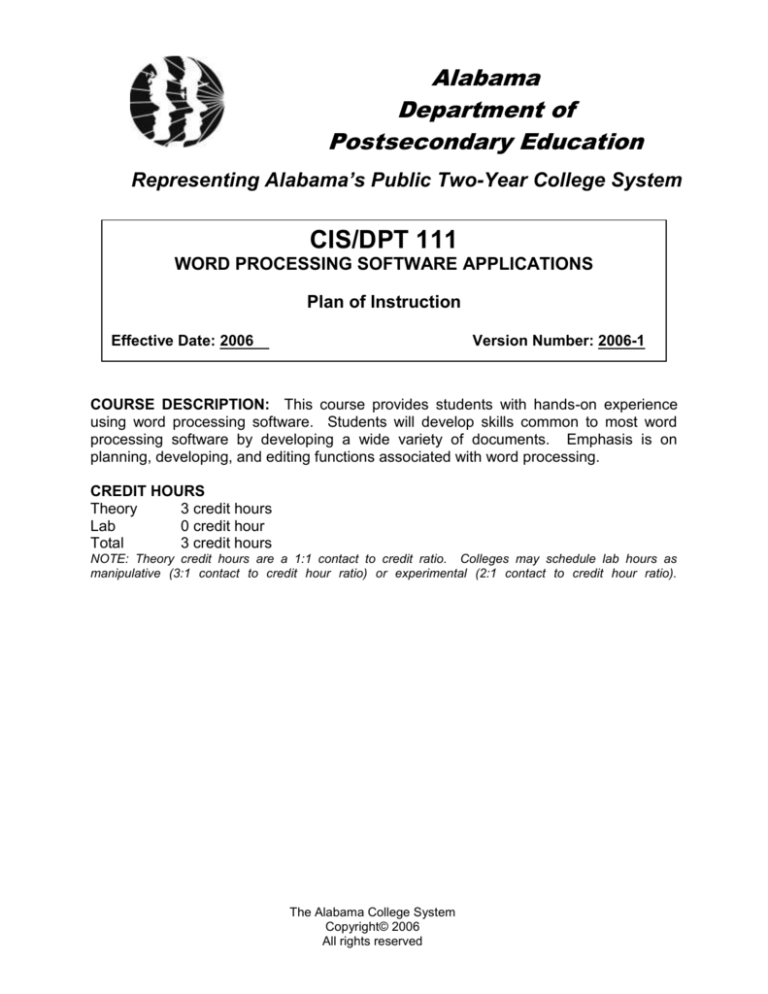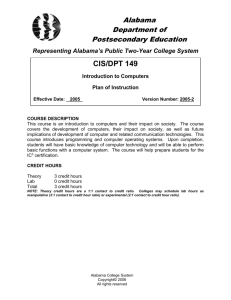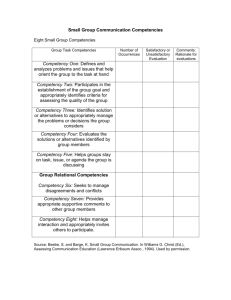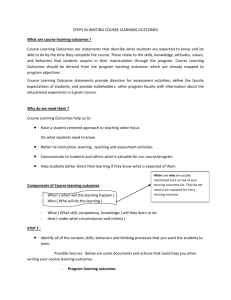
Alabama
Department of
Postsecondary Education
Representing Alabama’s Public Two-Year College System
CIS/DPT 111
WORD PROCESSING SOFTWARE APPLICATIONS
Plan of Instruction
Effective Date: 2006
Version Number: 2006-1
COURSE DESCRIPTION: This course provides students with hands-on experience
using word processing software. Students will develop skills common to most word
processing software by developing a wide variety of documents. Emphasis is on
planning, developing, and editing functions associated with word processing.
CREDIT HOURS
Theory
3 credit hours
Lab
0 credit hour
Total
3 credit hours
NOTE: Theory credit hours are a 1:1 contact to credit ratio. Colleges may schedule lab hours as
manipulative (3:1 contact to credit hour ratio) or experimental (2:1 contact to credit hour ratio).
The Alabama College System
Copyright© 2006
All rights reserved
Word Processing Software Applications
CIS 111
PREREQUISITE COURSES
As determined by college.
CO-REQUISITE COURSES
As determined by college.
PROFESSIONAL COMPETENCIES
Explain the system and hardware associated with word processing.
Use word processing to create basic documents.
Use word processing to modify existing documents.
Perform formatting functions associated with word processing.
Create and modify tables in word processing documents.
Create and revise multiple columns in a document.
Use graphics, charts, and diagrams in word processing.
INSTRUCTOR NOTE: Keyboarding skills are required throughout this course.
GENERAL INSTRUCTIONAL OBJECTIVES
The cognitive objectives for this course are for each student to comprehend
foundational knowledge of word processing.
The psychomotor objectives for this course are for each student to apply foundational
knowledge of word processing.
There are no affective objectives for this course.
PROFESSIONAL COMPETENCIES/OJBECTIVES
Unless otherwise indicated, evaluation of student’s attainment of cognitive and
performance objectives is based on knowledge gained from this course. During
performance evaluations, students will be provided necessary tools, equipment,
materials, specifications, and any other resources necessary to accomplish the task.
Specifications may be in the form of, but not limited to, certification agencies, national
and state codes, health care facility policies, locally developed lab/clinical assignments,
or any combination of specifications.
ACS Copyright© 2006
All rights reserved
2
Word Processing Software Applications
CIS 111
MODULE A – COMPUTER ESSENTIALS
MODULE DESCRIPTION – This module is intended to ensure students have basic knowledge of
computer operation. This module is foundational for other instruction in this course.
PROFESSIONAL COMPETENCIES
A1.0 Explain the system and
hardware associated with word
processing. (B)
PERFORMANCE OBJECTIVES
A1.1 This competency is measured cognitively.
ENABLING OBJECTIVES
A1.1.1 Define terms associated with the computer system.
A1.1.2 Explain the function of hardware devices.
A1.1.3 Identify elements of the graphical user interface.
A1.1.4 Explain the process of launching and exiting programs.
A1.1.5 Explain various methods of file management.
MODULE A OUTLINE
Hardware devices
Graphical user interface (GUI)
Launching and exiting programs
File management
ACS Copyright© 2006
All rights reserved
KSA
Indicator
A
B
a
b
b
3
Word Processing Software Applications
CIS 111
MODULE B – INTRODUCTION TO WORD PROCESSING
MODULE DESCRIPTION – During this module students obtain knowledge and skills to create
basic word processing documents.
PROFESSIONAL COMPETENCIES
PERFORMANCE OBJECTIVES
B1.0 Use word processing to create
basic documents. (2b)
B1.1 Use specified word processing features to create
basic documents.
KSA
ENABLING OBJECTIVES
Indicator
B1.1.1 Define terms associated with word processing.
A
B1.1.2 Identify parts of the document window.
a
B1.1.3 Explain the importance of planning the document.
B
B1.1.4 State various techniques for entering text in a document.
b
B1.1.5 Explain the process for various methods to edit text.
b
B1.1.6 State the importance of naming and saving files.
A
B1.1.7 State the purpose of templates and wizards.
a
MODULE B OUTLINE
Terms
Document window
Menus and tool bars
o Customizing tool bars
Windows space view
Rulers
Pointers
o Shapes
o Functions
Creating documents
Planning the document
Entering text
Basic text editing
Naming and saving
Printing
Closing
Templates and wizards
ACS Copyright© 2006
All rights reserved
4
Word Processing Software Applications
CIS 111
MODULE C – WORKING WITH EXISTING DOCUMENTS
MODULE DESCRIPTION – During this module students learn to edit and modify documents
using a variety of techniques.
PROFESSIONAL COMPETENCIES
PERFORMANCE OBJECTIVES
C1.0 Use word processing to modify
existing documents. (2b)
C1.1 Use specified word processing features to modify
and save existing documents.
KSA
ENABLING OBJECTIVES
Indicator
C.1.1.1 Explain the process of opening existing documents.
b
C1.1.2 Explain various techniques to navigate through documents.
b
C1.1.3 State the purpose of selected advanced editing features.
a
C1.1.4 Explain the difference between save and save as functions.
B
MODULE C OUTLINE
Opening existing documents
Navigating a document
Advanced edit features
Spell check
Undo and redo
Displaying non-printing characters
Cut, copy, and paste
Drag and drop
Save as
ACS Copyright© 2006
All rights reserved
5
Word Processing Software Applications
CIS 111
MODULE D – FORMATTING DOCUMENTS
MODULE DESCRIPTION – During this module students obtain knowledge and skills to enhance
documents using various formatting techniques.
PROFESSIONAL COMPETENCIES
PERFORMANCE OBJECTIVES
D1.0 Perform formatting functions
associated with word processing.
(2b)
D1.1 Use selected features to format word processing
documents.
D1.2 Use selected features to format multiple page
word processing documents.
KSA
ENABLING OBJECTIVES
Indicator
D1.1.1 Describe the various formatting features common to word processing.
a
D1.1.2 State the function of various formatting features common to word
a
processing.
D1.1.3 State the steps for implementing various formatting features.
b
MODULE D OUTLINE
Character formatting
Font dialogue box
Copying formats
Inserting symbols
Paragraph formatting
Borders
Shading
Indenting
Spacing
Bullets and numbered lists
Tabs
Changing alignment
Line and paragraphing spacing
Document formatting
Views
Margins
Page breaks
Page layout
Formatting longer documents
Section breaks
Page centering
Headers and footers
Page numbering
Foot notes and end notes
Table of contents
Section formatting
Find and replace
Word count
Thesaurus
Automatically completing and correcting text
Grammar check
ACS Copyright© 2006
All rights reserved
6
Word Processing Software Applications
CIS 111
MODULE E - TABLES
MODULE DESCRIPTION – During this module students learn to create and modify tables.
Additionally students learn to use features associated with tables.
PROFESSIONAL COMPETENCIES
PERFORMANCE OBJECTIVES
E1.0 Create and modify tables in word
processing documents. (2b)
E1.1 Use word processing features to create and
modify tables.
E1.2 Use sorting and calculating features in tables.
KSA
ENABLING OBJECTIVES
Indicator
E1.1.1 Explain the importance of planning a table.
A
E1.1.2 Describe methods to create tables.
b
E1.1.3 State methods to enter text into tables.
a
E1.1.4 Explain various methods to navigate in tables.
b
E1.1.5 Describe various formatting and modifying features common to tables.
a
E1.1.6 Explain techniques to modify table properties.
b
E1.2.1 Explain the purpose of the sorting functions.
B
E1.2.2 Explain the process of performing data calculations.
b
MODULE E OUTLINE
Creating new tables
Planning a table
Inserting and drawing
Entering text into tables
Navigating in tables
Formatting and modifying tables
Borders and shading
Automatic Format
Rotating text
Inserting and deleting rows and columns
Merging
Table properties
Alignment
Sizing
Structure
Sorting
Calculating
ACS Copyright© 2006
All rights reserved
7
Word Processing Software Applications
CIS 111
MODULE F - COLUMNS
MODULE DESCRIPTION – During this module students learn to create and modify columns.
Additionally students learn to use features associated with columns.
PROFESSIONAL COMPETENCIES
PERFORMANCE OBJECTIVES
F1.0 Create and revise multiple
columns in a document. (2b)
F1.1 Use word processing features to create and
revise columns.
KSA
ENABLING OBJECTIVES
Indicator
F1.1.1 Describe methods to create columns.
b
F1.1.2 State methods to enter text into columns.
a
F1.1.3 Explain various methods to navigate in columns.
b
F1.1.4 Describe techniques to revise column layout.
b
F1.1.5 Describe the method to create dropped capital letters.
b
MODULE F OUTLINE
Creating multiple column layouts
Entering and editing texts
Revising column layout
Column breaks
Applying styles
Balancing column length
Creating drop caps
ACS Copyright© 2006
All rights reserved
8
Word Processing Software Applications
CIS 111
MODULE G – GRAPHICS
MODULE DESCRIPTION – During this module students learn to incorporate various types of
graphics into word processing documents.
PROFESSIONAL COMPETENCIES
PERFORMANCE OBJECTIVES
G1.0 Use graphics, charts, and
diagrams in word processing.
(2b)
G1.1 Insert and modify graphics in a word processing
document.
G1.2 Create diagrams and charts in a word processing
document.
KSA
ENABLING OBJECTIVES
Indicator
G1.1.1 Explain various methods to insert images into a document.
b
G1.1.2 Explain the process of inserting graphic fonts into a document.
b
G1.1.3 Explain the process of modifying the location of graphics in a document.
b
G1.1.4 Explain the process of inserting text boxes in a document.
b
G1.1.5 Explain the process of changing object properties in a document.
b
G1.1.6 Explain the function of selected graphic toolbar features.
B
MODULE G OUTLINE
Locating images
Inserting images
Graphic fonts
Selecting, moving, and deleting
Text boxes
Changing object properties
Resizing
Text wrap
Diagrams and charts
Graphic toolbar features
ENABLING OBJECTIVES TABLE OF SPECIFICATIONS
The table below identifies the percentage of cognitive objectives for each module. Instructors
should develop sufficient numbers of test items at the appropriate level of evaluation.
Module A
Module B
Module C
Module D
Module E
Module F
Module G
ACS Copyright© 2006
All rights reserved
Facts/
Nomenclature
Principles/
Procedures
A/a
40%
57%
25%
67%
29%
20%
-
B/b
60%
43%
75%
33%
71%
80%
100%
Analysis/
Operating
Principles
C/c
-
Evaluation/
Complete
Theory
D/d
-
9
Word Processing Software Applications
CIS 111
Knowledge, Skills, and Attitudes (KSA) Indicators
Value
Key Word(s)
Highly
Proficient
Affective
Knowledge
Knowledge of
Skills
Performance
Ability
4
Definition
Performs competency quickly and accurately. Instructs others how to do
the competency.
Performs all parts of the competency. Needs only a spot check of
completed work.
3
Proficient
2
Partially
Proficient
Performs most parts of the competency. Needs help only on hardest parts.
1
Limited Proficiency
Performs simple parts of the competency. Needs to be told or shown how
to do most of the competency.
b
a
D
C
Complete
Theory
Operating
Principles
Procedures
Nomenclature
Evaluation
Analysis
B
Principles
A
Facts
*5
Characterization by
Value
*4
Organization
*3
Valuing
*2
Responding
*1
Receiving
d
c
Predicts, isolates, and resolves problems about the competency.
Identifies why and when the competency must be done and why each step
is needed.
Determines step-by-step procedures for doing the competency.
Names parts, tools, and simple facts about the competency.
Evaluates conditions and makes proper decisions about the subject.
Analyzes facts and principles and draws conclusions about the subject.
Identifies relationship of basic facts and states general principles about the
subject.
Identifies basic facts and terms about the subject.
Acting consistently with the new value
Integrating a new value into one's general set of values, giving it some
ranking among one's general priorities
Showing some definite involvement or commitment
Showing some new behaviors as a result of experience
Being aware of or attending to something in the environment
Alpha Scale Values - Any item with an upper case letter (A, B, C, D) by itself is taught as general information on a topic. This information may be related to the
competency or encompass multiple competencies. Examples might include mathematical computations or knowledge of principles such as Ohm’s Law.
A lower case letter indicates a level of ”Knowledge of Skills." Individuals are taught information pertaining to performing a competency . These may be indicated
alone or in conjunction with a numerical scale value. A lower case letter by itself indicates the individual is not required to perform the task-just know about the task.
(example: Can state or explain procedures for doing a task).
Numerical Scale Values - The numbers reflect the levels the individual will be able to perform a competency. Number values are always accompanied by lower
case letters (i.e. 1a, 2b, 3c...etc.) in order to specify the level of knowledge of skills associated with the competency.
Example: An individual with a competency with a scale indicator of 3b has received training of knowledge of skills whereby he or she can determine the correct
procedures and perform with limited supervision; only requiring evaluation of the finished product or procedure.
Asterisk items indicate desired affective domain levels and are used to indicate the desired level for a given competency. They may be used independently or with
other indicators (i.e. 1a-*1, 2c-*3). If used with another indicator, separate with a hyphen.
NOTE: Codes indicate terminal values.
ACS Copyright© 2006
All rights reserved
10









